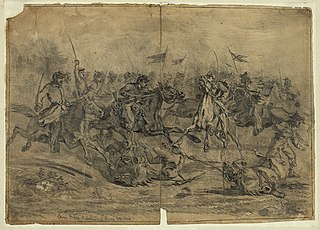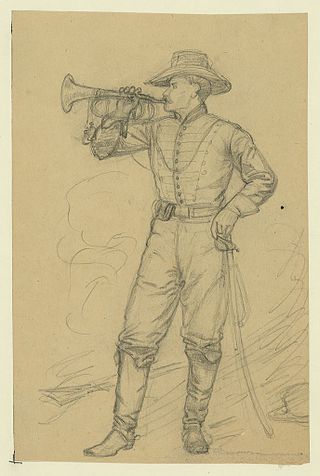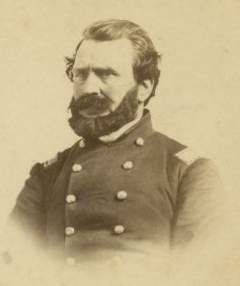Related Research Articles
The Confederate order of battle during the Battle of Gettysburg includes the American Civil War officers and men of the Army of Northern Virginia. Order of battle compiled from the army organization during the battle, the casualty returns and the reports.

The Battle of Brandy Station, also called the Battle of Fleetwood Hill, was the largest predominantly cavalry engagement of the American Civil War, as well as the largest ever to take place on American soil. It was fought on June 9, 1863, around Brandy Station, Virginia, at the beginning of the Gettysburg Campaign by the Union cavalry under Maj. Gen. Alfred Pleasonton against Maj. Gen. J. E. B. Stuart's Confederate cavalry.

The Battle of Kelly's Ford, also known as the Battle of Kellysville or Kelleysville, took place on March 17, 1863, in Culpeper County, Virginia, as part of the cavalry operations along the Rappahannock River during the American Civil War. It set the stage for Brandy Station and other cavalry actions of the Gettysburg Campaign that summer. Twenty-one hundred troopers of Brig. Gen. William W. Averell's Union cavalry division crossed the Rappahannock to attack the Confederate cavalry that had been harassing them that winter. Brig. Gen. Fitzhugh Lee counterattacked with a brigade of about 800 men. After achieving a localized success, Union forces withdrew under pressure in late afternoon, without destroying Lee's cavalry.

William Edmondson "Grumble" Jones was a Confederate cavalry general with a reputation for being a martinet to his troopers and fractious toward superiors, but acknowledged to be a good commander. After disagreements of a personal nature with J.E.B. Stuart, Jones's brigade was set to guarding supply lines and unavailable during a crucial juncture of the Gettysburg Campaign when Lee suffered from a lack of capable reconnaissance cavalry. As the personality clash between Jones and Stuart escalated, Jones faced charges for impertinence, and was transferred to separate him from Stuart. Jones was killed leading a counter-attack in the 1864 Battle of Piedmont.

Fitzhugh "Fitz" Lee was a Confederate cavalry general in the American Civil War, the 40th Governor of Virginia, diplomat, and United States Army general in the Spanish–American War. He was the son of Sydney Smith Lee, a captain in the Confederate States Navy, and the nephew of Robert E. Lee.

The Appomattox campaign was a series of American Civil War battles fought March 29 – April 9, 1865, in Virginia that concluded with the surrender of Confederate General Robert E. Lee's Army of Northern Virginia to forces of the Union Army under the overall command of Lieutenant General Ulysses S. Grant, marking the effective end of the war.

John Randolph Chambliss Jr. was a career military officer from Virginia who served in the Confederate States Army. He reached the rank of brigadier general of cavalry before being killed in action in August 1864 during the Second Battle of Deep Bottom. Born to a lawyer, Colonel and Mrs John Chambliss of Hicksford, Va, John, jr. graduated from West Point (1853) with several future generals, particularly his friend David McGregg, a future Union General as their paths would have an ominous crossing in August 1864.
The following Confederate States Army units and commanders fought in the Second Battle of Bull Run, called the Second Battle of Manassas by Confederate records, of the American Civil War. The Union order of battle is listed separately. Order of battle compiled from the army organization during the battle, the casualty returns and the reports.
The following Confederate States Army units and commanders fought in the Battle of Antietam of the American Civil War. The Union order of battle is listed separately. Order of battle compiled from the army organization during the campaign, the casualty returns and the reports.
The following Confederate States Army units and commanders fought in Virginia's Battle of Chancellorsville, which lasted from April 30 to May 6, 1863, during the American Civil War. The Union order of battle is listed separately. Order of battle has been compiled from the army organization during the campaign, the casualty returns and the reports.
The following Confederate States Army units and commanders fought in the Battle of Fredericksburg of the American Civil War. Order of battle compiled from the army organization during the campaign. The Union order of battle is listed separately.
The following Confederate States Army units and commanders fought in the Battle of the Wilderness of the American Civil War. The Union order of battle is listed separately. Order of battle compiled from the army organization May 5–6, 1864, the army organization at beginning of the Campaign, the army organization during the Campaign and the reports.
The following Confederate States Army units and commanders fought in the Battle of Spotsylvania Court House of the American Civil War. The Union order of battle is listed separately. Order of battle compiled from the army organization May 7–12, 1864, army organization May 13–25, 1864, the army organization during the Campaign and the reports.

The 53rd Pennsylvania Volunteer Infantry was a volunteer infantry regiment in the Union Army during the American Civil War.

James Parker Landis was an American soldier who served in the Union Army during the American Civil War. He received the Medal of Honor for the capture of a Confederate flag during the Battle of Amelia Springs while serving as the Chief Bugler of the 1st Pennsylvania Cavalry.
The following Confederate States Army units and commanders fought in the Bristoe campaign of the American Civil War. The Union order of battle is listed separately. Order of battle compiled from the army organization from September 30, 1863, the casualty returns and the reports.

William Wallace Robinson, Sr., was a Union Army officer and American diplomat. He commanded the 7th Wisconsin Infantry Regiment in the famed Iron Brigade of the Army of the Potomac through most of the Civil War, and was U.S. consul to the Merina Kingdom of Madagascar for 12 years (1875–1887).
The following units and commanders fought in the Battle of Brandy Station of the American Civil War on the Union side. The Confederate order of battle is shown separately. Order of battle compiled from the army organization during the battle.

The Battle of Fairfax Court House was fought during the Gettysburg Campaign of the American Civil War between two cavalry detachments from the Union Army of the Potomac, commanded by General Joseph Hooker, and the Confederate Army of Northern Virginia, commanded by General Robert E. Lee.

The 5th New York Cavalry Regiment, also known as the 5th Regiment New York Volunteer Cavalry and nicknamed the "1st Ira Harris Guards", was a cavalry regiment of the Union Army during the American Civil War. The regiment had a good fighting reputation, and had important roles in the Battle of Hanover and the Battle of the Wilderness. It was present at nearly 175 battles and skirmishes, including Gettysburg, Opequon, and Cedar Creek. A majority of its fighting was in Virginia.
References
- The Battle of Brandy Station
- U.S. War Department, The War of the Rebellion Archived 2009-09-13 at the Wayback Machine : a Compilation of the Official Records of the Union and Confederate Armies. Washington, DC: U.S. Government Printing Office, 1880–1901.